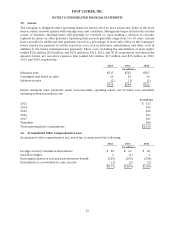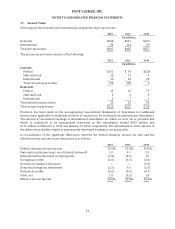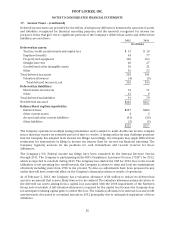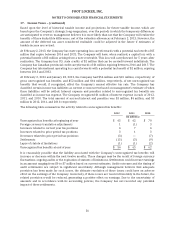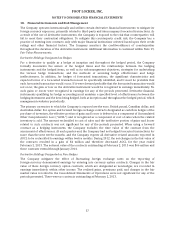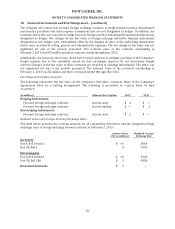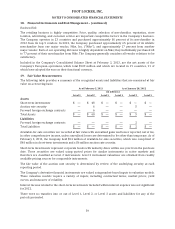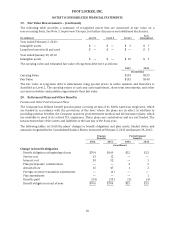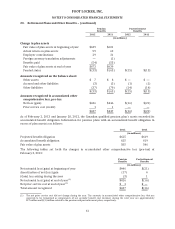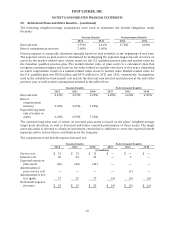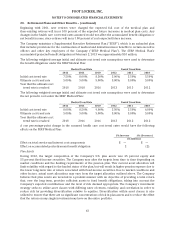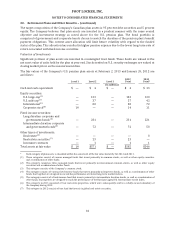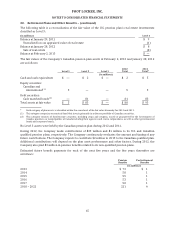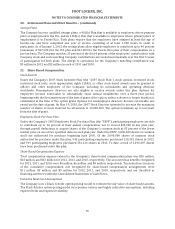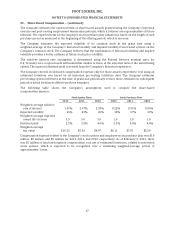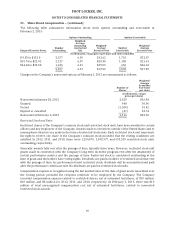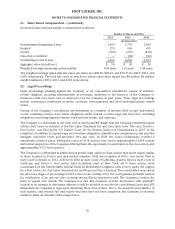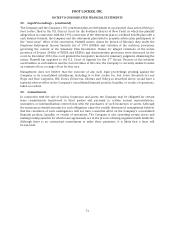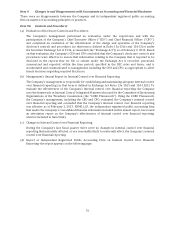Foot Locker 2012 Annual Report Download - page 83
Download and view the complete annual report
Please find page 83 of the 2012 Foot Locker annual report below. You can navigate through the pages in the report by either clicking on the pages listed below, or by using the keyword search tool below to find specific information within the annual report.
FOOT LOCKER, INC.
NOTES TO CONSOLIDATED FINANCIAL STATEMENTS
20. Retirement Plans and Other Benefits − (continued)
Beginning with 2001, new retirees were charged the expected full cost of the medical plan and
then-existing retirees will incur 100 percent of the expected future increases in medical plan costs. Any
changes in the health care cost trend rates assumed would not affect the accumulated benefit obligation or
net benefit income, since retirees will incur 100 percent of such expected future increase.
The Company maintains a Supplemental Executive Retirement Plan (‘‘SERP’’), which is an unfunded plan
that includes provisions for the continuation of medical and dental insurance benefits to certain executive
officers and other key employees of the Company (‘‘SERP Medical Plan’’). The SERP Medical Plan’s
accumulated projected benefit obligation at February 2, 2013 was approximately $10 million.
The following weighted-average initial and ultimate cost trend rate assumptions were used to determine
the benefit obligations under the SERP Medical Plan:
Medical Trend Rate Dental Trend Rate
2012 2011 2010 2012 2011 2010
Initial cost trend rate 7.50% 8.00% 8.50% 5.00% 5.50% 5.50%
Ultimate cost trend rate 5.00% 5.00% 5.00% 5.00% 5.00% 5.00%
Year that the ultimate cost
trend rate is reached 2018 2018 2016 2013 2013 2012
The following weighted-average initial and ultimate cost trend rate assumptions were used to determine
the net periodic cost under the SERP Medical Plan:
Medical Trend Rate Dental Trend Rate
2012 2011 2010 2012 2011 2010
Initial cost trend rate 8.00% 8.50% 9.00% 5.50% 5.50% 6.00%
Ultimate cost trend rate 5.00% 5.00% 5.00% 5.00% 5.00% 5.00%
Year that the ultimate cost
trend rate is reached 2018 2016 2016 2013 2012 2012
A one percentage-point change in the assumed health care cost trend rates would have the following
effects on the SERP Medical Plan:
1% Increase 1% (Decrease)
(in millions)
Effect on total service and interest cost components $ — $ —
Effect on accumulated postretirement benefit obligation 2 (2)
Plan Assets
During 2012, the target composition of the Company’s U.S. plan assets was 45 percent equity and
55 percent fixed-income securities. The Company may alter the targets from time to time depending on
market conditions and the funding requirements of the pension plan. This current asset allocation will
limit volatility with regard to the funded status of the plan, but will result in higher pension expense due to
the lower long-term rate of return associated with fixed-income securities. Due to market conditions and
other factors, actual asset allocations may vary from the target allocation outlined above. The Company
believes that plan assets are invested in a prudent manner with an objective of providing a total return
that, over the long term, provides sufficient assets to fund benefit obligations, taking into account the
Company’s expected contributions and the level of risk deemed appropriate. The Company’s investment
strategy seeks to utilize asset classes with differing rates of return, volatility, and correlation in order to
reduce risk by providing diversification relative to equities. Diversification within asset classes is also
utilized to ensure that there are no significant concentrations of risk in plan assets and to reduce the effect
that the return on any single investment may have on the entire portfolio.
63


